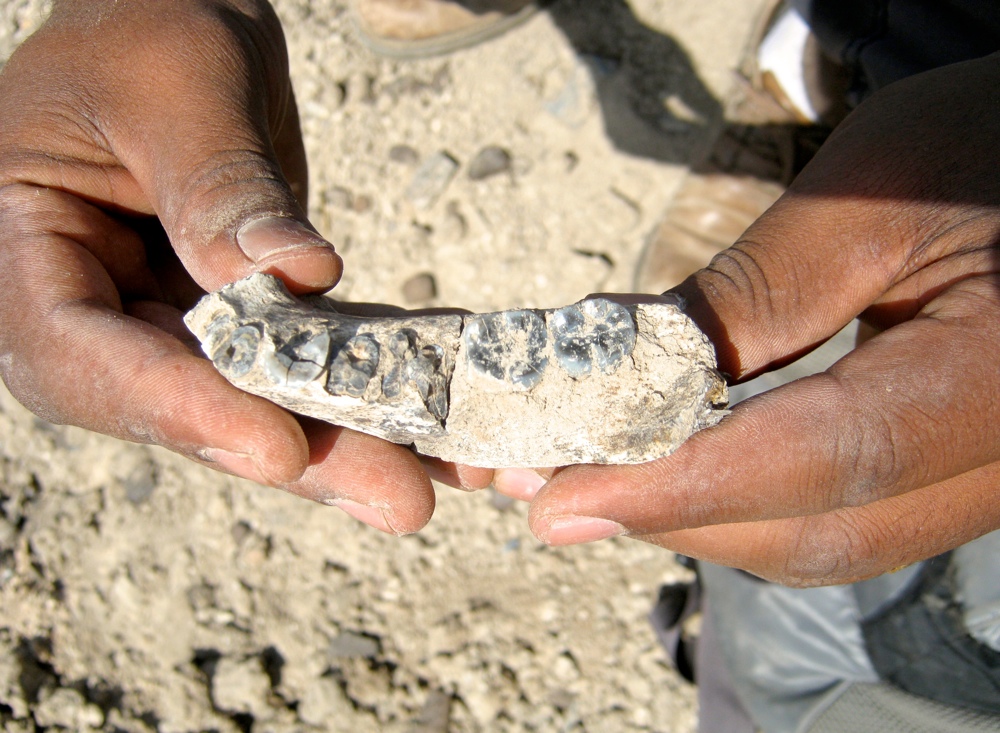A newly discovered fragment from an ancient jawbone may be the oldest known human fossil found yet. The bone is perhaps from a new species of human, another primate similar to us of the genus Homo, suggesting that the human family of primates may have come into existence over half a million years earlier than anthropologists once thought.
Perhaps more importantly, this new discovery has revealed the type of environment from which our closest ancestors came, said the researchers.
While modern day humans are all that’s left of the human lineage today, we were only one of a handful of human species to roam the Earth, competing against such hominids as Neanderthals for food.
When Charles Darwin first wrote about human evolution he suspected that Africa, home to several lines of large apes would likely contain the fossils of our ancestors. By the early 20th century, as paleontologists like Raymond Dart and Mary Leakey found remnants of early humans in Tanzania and South Africa, they seemed to fulfill that prediction, giving way to an “Out of Africa” hypothesis of human migration. There was plenty of evidence for tool making and walking upright, but while scientists have known for awhile that these species were tribal by nature, the question of when the concept of human families actually began.
The new find in Ethiopia is about 2.8 million years old, an important supplement to the gap in the fossil record between 2.5 and 3 million years ago. The paper describing the find was published Wednesday in the journal Science.
“There’s virtually nothing relating to the ancestors of Homo from that time period, in spite of a lot of people looking,” said the research team’s co-leader and paper co-author Brian Villmoare, a paleoanthropologist from the University of Nevada in Las Vegas, in an interview with Live Science. “Now we have a fossil of Homo from this time, the earliest evidence of Homo yet.
The jaw was discovered by their team member Chalachew Seyoum back in 2013, near the Ledi-Geraru research area of Ethiopia’s Afar region. “One hill was particularly rich in fossils — it was probably a bend in a stream, where bones tended to gather after animals died,” Villmoare said. “We found this fossil coming out of that hill.”
The fossil, labeled as LD 350-1, is a preserved left side of a hominid’s lower jaw containing five teeth. “Once we found it, we knew immediately what it was — we could tell it was a human ancestor,” Villmoare said. “We were jumping up and down the side of that hill.”
In order to determine the fossil’s age, the researchers did an analysis of the layers of volcanic ash it was buried in – both above and beneath the fossil. “When volcanoes erupt, they send out a layer of ash that contains radioactive isotopes, and these isotopes start going through radioactive decay,” Villmoare explained. “We can use this to figure out how old those layers of ash are.”
The fossil was actually found not too far from Hadar, the archaeological site that was once home to Australopithecus afarensis, our ancient ape-like ancestors that included the famous “Lucy,” who was thought to be the earliest of our ancestors to care for its young post-infancy. The original owner of LD 350-1 likely lived only 200,000 years after Lucy, and although its sloping, primeval chin is reminiscent of Australopithecus, the teeth and size of the jaw suggest that this creature was actually a member of the Homo genus. It seems like a perfect transition, with ape-like features as well as those closer to a modern human.
“It’s a mixture of more primitive traits from Australopithecus with quite a few traits only seen in later Homo. The scientists do not yet know whether this fossil belongs to a new species or to a known, extinct human species such as Homo habilis,” Villmoare said.
As exciting as the possibility of a newly discovered hominid may be, the researchers are hardly jumping to conclusions just yet – determined to know everything they can about their specimen first.
“We are holding back on that — we are hoping to find more of it, learn more about what it looked like, before we give the species a name,” Villmoare said.
Other geologic evidence at the site suggests that their location closely resembled modern African settings such as the Serengeti Plains or the Kalahari at the time that their specimen lived. It likely settled in what was a grassland with lots of shrubs. It shared a nearby lake with hippos, antelope, elephants, crocodiles and fish, in an age before the climate began to intensify dramatically, which would force its descendants northward.
“We can see the 2.8 million-year-old aridity signal in the Ledi-Geraru faunal community,” said the research team’s co-leader and study co-author Kaye Reed of Arizona State University, in a statement. “But it’s still too soon to say that this means climate change is responsible for the origin of Homo. We need a larger sample of hominin fossils and that’s why we continue to come to the Ledi-Geraru area to search.”
|
James Sullivan
James Sullivan is the assistant editor of Brain World Magazine and a contributor to Truth Is Cool and OMNI Reboot. He can usually be found on TVTropes or RationalWiki when not exploiting life and science stories for another blog article. |

